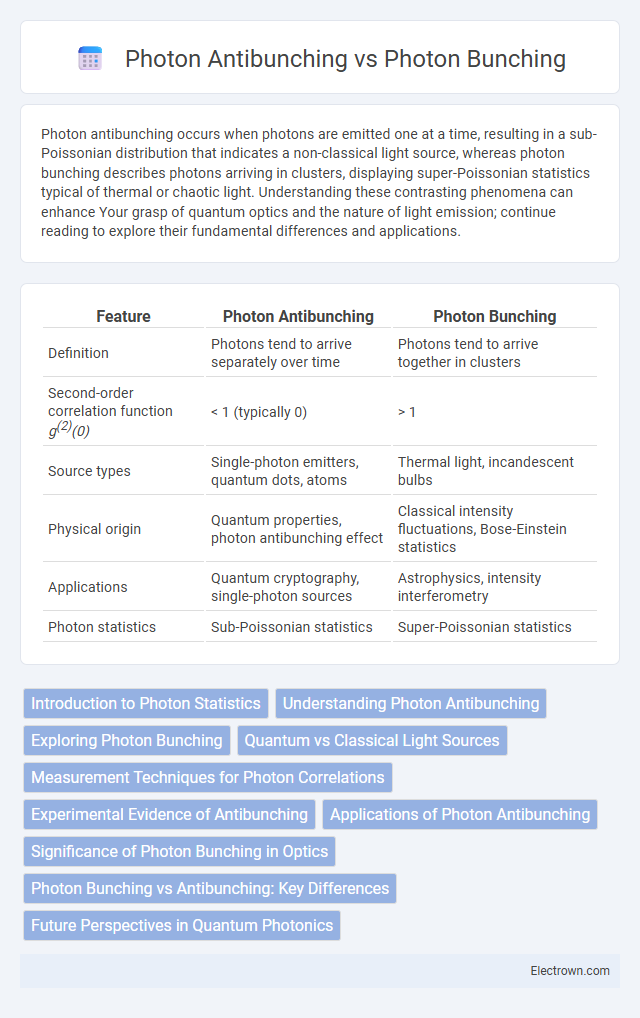Photon antibunching occurs when photons are emitted one at a time, resulting in a sub-Poissonian distribution that indicates a non-classical light source, whereas photon bunching describes photons arriving in clusters, displaying super-Poissonian statistics typical of thermal or chaotic light. Understanding these contrasting phenomena can enhance Your grasp of quantum optics and the nature of light emission; continue reading to explore their fundamental differences and applications.
Table of Comparison
| Feature | Photon Antibunching | Photon Bunching |
|---|---|---|
| Definition | Photons tend to arrive separately over time | Photons tend to arrive together in clusters |
| Second-order correlation function g(2)(0) | < 1 (typically 0) | > 1 |
| Source types | Single-photon emitters, quantum dots, atoms | Thermal light, incandescent bulbs |
| Physical origin | Quantum properties, photon antibunching effect | Classical intensity fluctuations, Bose-Einstein statistics |
| Applications | Quantum cryptography, single-photon sources | Astrophysics, intensity interferometry |
| Photon statistics | Sub-Poissonian statistics | Super-Poissonian statistics |
Introduction to Photon Statistics
Photon antibunching and photon bunching represent two fundamental behaviors in photon statistics, reflecting the temporal distribution of photon arrival times. Photon antibunching occurs when photons are emitted one at a time with a reduced probability of simultaneous detection, indicating non-classical light sources like single-photon emitters. Photon bunching describes the tendency of photons to arrive in clusters, characteristic of classical thermal or chaotic light sources, revealing underlying quantum statistical properties useful for analyzing light coherence and quantum optics phenomena.
Understanding Photon Antibunching
Photon antibunching is a quantum optical phenomenon where photons are emitted one at a time, leading to a reduced probability of detecting two or more photons simultaneously. This behavior contrasts with photon bunching, where photons tend to arrive in groups, typical of thermal or chaotic light sources. Understanding photon antibunching is crucial for developing single-photon sources used in quantum cryptography and quantum computing.
Exploring Photon Bunching
Photon bunching occurs when photons tend to arrive together, creating bursts of light characterized by a higher probability of simultaneous detection. This behavior is typical of thermal or chaotic light sources, where the intensity fluctuations lead to correlated photon emission, unlike photon antibunching, which signifies a quantum emitter producing photons one at a time. Understanding photon bunching helps researchers analyze the statistical properties of light, revealing information about the underlying quantum state and coherence of your light source.
Quantum vs Classical Light Sources
Photon antibunching is a hallmark of quantum light sources, indicating that photons are emitted one at a time, a behavior impossible in classical light where photons tend to cluster, known as photon bunching. Classical light sources, such as thermal or incandescent lamps, exhibit photon bunching due to the statistical nature of light intensity fluctuations, described by classical wave theory. In contrast, quantum emitters like single atoms, quantum dots, or nitrogen-vacancy centers in diamonds produce photon antibunching, revealing the discrete, particle-like properties of photons fundamental to non-classical light.
Measurement Techniques for Photon Correlations
Measurement techniques for photon correlations primarily involve second-order correlation functions (g2(t)) using a Hanbury Brown and Twiss (HBT) setup, which splits incoming photons into two detectors to analyze temporal photon arrival statistics. Photon antibunching, characterized by g2(0) < 1, indicates single-photon emission and is detected by observing a dip at zero delay time, while photon bunching, with g2(0) > 1, reveals clustered photon arrivals typical in thermal or chaotic light sources. Your experiments benefit from using time-correlated single-photon counting (TCSPC) modules to precisely resolve these correlations, enabling accurate distinction between antibunched and bunched photon streams.
Experimental Evidence of Antibunching
Photon antibunching is experimentally observed through measurements using a Hanbury Brown and Twiss interferometer, where the second-order correlation function g^(2)(0) drops below 1, signaling single-photon emitters and non-classical light behavior. In contrast, photon bunching exhibits g^(2)(0) values greater than 1, indicating thermal or chaotic light sources where photons tend to group temporally. You can identify antibunching in quantum dot emission experiments or single atom fluorescence, confirming discrete photon emission events critical for quantum information applications.
Applications of Photon Antibunching
Photon antibunching is a quantum optical phenomenon where photons are emitted one at a time, demonstrating non-classical light behavior essential for quantum cryptography and single-photon source development. This property enables secure quantum key distribution by providing true single-photon generation that prevents eavesdropping in communication systems. Photon antibunching is also crucial in quantum computing and high-resolution microscopy, where precise control over photon emission enhances performance and measurement accuracy.
Significance of Photon Bunching in Optics
Photon bunching is a crucial phenomenon in quantum optics, indicating the tendency of photons to arrive simultaneously or in groups, revealing the statistical properties of light sources. It plays a significant role in characterizing thermal or chaotic light, where photons exhibit correlated arrival times, influencing the design of optical communication systems and quantum information processing. Understanding photon bunching helps optimize your photonic devices by improving coherence and enhancing signal detection sensitivity.
Photon Bunching vs Antibunching: Key Differences
Photon bunching occurs when photons tend to arrive together, leading to an increased probability of simultaneous detection, characteristic of classical or thermal light sources. Photon antibunching, a quantum phenomenon observed in single-photon emitters like quantum dots or atoms, shows photons arriving one at a time with reduced probability of coincidence detection. Understanding these phenomena helps you distinguish between classical light behavior and quantum light emission critical for applications in quantum communication and photonics.
Future Perspectives in Quantum Photonics
Photon antibunching, characterized by the emission of photons one at a time, is pivotal for developing secure quantum communication and scalable quantum computing architectures. Photon bunching, with simultaneous photon emission, enables enhanced sensitivity in quantum metrology and imaging techniques. Your exploration of these effects can drive innovations in quantum light sources and improve the performance of next-generation quantum photonic devices.
photon antibunching vs photon bunching Infographic

 electrown.com
electrown.com